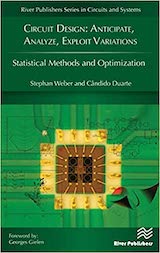
|
FreeComputerBooks.com
Links to Free Computer, Mathematics, Technical Books all over the World
|
|
- Title: Circuit Design: Anticipate, Analyze, Exploit Variations
- Author(s) Stephan Weber, Candido Duarte
- Publisher: River Publishers (2017); eBook (River Publishers, 2022; Creative Commons Licensed)
- License(s): CC BY 4.0
- Hardcover: 638 pages
- eBook: PDF
- Language: English
- ISBN-10/ASIN: 8793379757/B0BCXSSPZP
- ISBN-13: 978-8793379756
- Share This:

|
Circuit Design = Science + Art! Designers need a skilled "gut feeling" about circuits and related analytical techniques, plus creativity, to solve all problems and to adhere to the specifications, the written and the unwritten ones.
This book starts with best-practise manual methods and links them tightly to up-to-date automation algorithms. It provides many tractable examples and explain key techniques you have to know.
The book is written for engineers, students in engineering and CAD / methodology experts. Readers should have some background in standard design techniques like entering a design in a schematic capture and simulating it, and also know about major technology aspects.
About the Authors- N/A
- Electronics Circuit Design and Programming, Microcontrollers, PLC, VLSI, etc.
- Very Large Scale Integration (VLSI)
- HDL (VHDL, Verilog, FPGA, etc.)
- Electronic Engineering

- Circuit Design: Anticipate, Analyze, Exploit Variations (Stephan Weber, et al)
- The Mirror Site (1) - PDF
-
 Digital Integrated Circuit Design: VLSI Architectures to CMOS
Digital Integrated Circuit Design: VLSI Architectures to CMOS
This practically oriented textbook covers the important aspects of VLSI design using a top-down approach, reflecting the way digital circuits are actually designed, using practical hints and tips, case studies and checklists.
-
 Digital Systems Design (Ramaswamy Palaniappan)
Digital Systems Design (Ramaswamy Palaniappan)
This book provides readers with a fundamental understanding of digital system concepts such as logic gates for combinatorial logic circuit design and higher level logic elements such as counters and multiplexers.
-
 Designing Analog Chips (Hans Camenzind)
Designing Analog Chips (Hans Camenzind)
A comprehensive introduction to CMOS and bipolar analog IC design. The book presumes no prior knowledge of linear design, making it comprehensible to engineers with a non-analog background.
-
 Compact Models for Integrated Circuit Design
Compact Models for Integrated Circuit Design
This book provides a modern treatise on compact models for circuit computer-aided design (CAD), offers a balanced presentation of compact modeling crucial for addressing current modeling challenges and understanding new models for emerging devices.
-
 Flexible Circuit Technology (Joseph Fjelstad)
Flexible Circuit Technology (Joseph Fjelstad)
This book was written to provide a bridge of understanding by offering a clearly defined set of steps which take the reader from basic concepts of flexible circuits to a more detailed review of the various technology and materials.
-
 Application-Specific Integrated Circuits (Michael J. Smith)
Application-Specific Integrated Circuits (Michael J. Smith)
This comprehensive book on application-specific integrated circuits (ASICs) describes the latest methods in VLSI-systems design. The book covers both semicustom and programmable ASIC types.
-
 Circuit Design Using Personal Computers (Thomas R. Cuthbert)
Circuit Design Using Personal Computers (Thomas R. Cuthbert)
This practical guide to designing electronic circuits using small computers and programmable calculators makes it easy to implement both classical and sophisticated design techniques.
-
 Lessons in Electric Circuits (Tony R. Kuphaldt)
Lessons in Electric Circuits (Tony R. Kuphaldt)
A 6 volumes series of textbooks on the subjects of electricity and electronics. This book was written to be a good enough book without delving too heavy on the math, while still maintaining a lot of important information.
-
 DC Electrical Circuit Analysis: A Practical Approach (James Fiore)
DC Electrical Circuit Analysis: A Practical Approach (James Fiore)
Basic concepts are introduced such as charge, current, energy, power and voltage. Covering analysis techniques such as superposition, source conversions, mesh analysis, nodal analysis, , Thévenin's and Norton's theorems, and delta-wye conversions, etc.
-
 AC Electrical Circuit Analysis: A Practical Approach (James Fiore)
AC Electrical Circuit Analysis: A Practical Approach (James Fiore)
Cover topics including series, parallel, and series-parallel RLC circuits. Numerous theorems and analysis techniques are examined including superposition, Thévenin's theorem, nodal and mesh analysis, maximum power transfer and more.
-
 Digital System Design - Use of Microcontroller
Digital System Design - Use of Microcontroller
This book concentrates on the use of a microcontroller as the Embedded System's processor and how to use it in many embedded system applications. It covers both the hardware and software aspects needed to design using microcontrollers.
-
 What's a Microcontroller? (Andy Lindsay)
What's a Microcontroller? (Andy Lindsay)
The book answers the question "What's a Microcontroller?" by showing students how they can design their own customized, intelligent inventions using the BASIC Stamp. This text is designed to accommodate a wide range of ages and skill levels.





